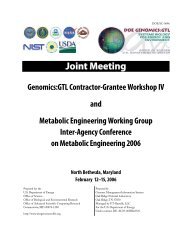2005 gtl abstracts.indb - Genomics - U.S. Department of Energy
2005 gtl abstracts.indb - Genomics - U.S. Department of Energy
2005 gtl abstracts.indb - Genomics - U.S. Department of Energy
Create successful ePaper yourself
Turn your PDF publications into a flip-book with our unique Google optimized e-Paper software.
<strong>Genomics</strong>:GTL Program Projects<br />
is feasible that a large fraction <strong>of</strong> such errors is due to the absence <strong>of</strong> the underlying correct<br />
answer in the database. In such cases the returned match bound to be an incorrect one, but still<br />
may have relatively high X-correlation value. In our approach such spectra immediately become<br />
candidates for further study, such as Post Translational Modification (PTM) search or further<br />
de novo processing.<br />
Summarizing, our testing indicates the following:<br />
24 * Presenting author<br />
•<br />
•<br />
•<br />
Even with the existing technology (which certainly could be improved) reliable de novo tags<br />
can be constructed for a large majority <strong>of</strong> MS/MS spectra – and virtually for all high quality<br />
spectra.<br />
When de novo solution is compatible with the database, it is almost always the same as provided<br />
by SEQUEST. This conclusion confirms a high reliability <strong>of</strong> the SEQUEST identifications<br />
in the cases when the expected peptides are present in the protein database.<br />
There is a significant fraction <strong>of</strong> spectra (~33% for medium X-correlation values, ~50% low<br />
X-corr values), where the PPM-Chain finds good de novo tags not compatible with anything<br />
in the target database. Some <strong>of</strong> these tags definitely reflect complex and interesting biological<br />
phenomena, where PTMs and point mutations are blocking the possibility <strong>of</strong> finding the correct<br />
answers in the “plain vanilla” database searches.<br />
For a future work we plan to apply PPM-chain for a comprehensive data extraction from the<br />
proteomics samples aiming at low abundance proteins as well as interesting biological facts, such as<br />
PTMs and mutated proteins. Our results strongly suggest that this approach will not only increase<br />
the output <strong>of</strong> useful information, but will also eliminate significant part <strong>of</strong> incorrect identification,<br />
further improving quality <strong>of</strong> the corresponding proteomics studies.<br />
This work was funded in part by the US <strong>Department</strong> <strong>of</strong> <strong>Energy</strong>'s <strong>Genomics</strong>:GTL program (www.doegenomestolife.<br />
org) under two projects, “Carbon Sequestration in Synechococcus Sp.: From Molecular Machines to Hierarchical Modeling”<br />
(www.genomes-to-life.org) and “Center for Molecular and Cellular Systems” (www.ornl.gov/GenomestoLife).<br />
16<br />
The Transcriptome <strong>of</strong> a Marine Cyanobacterium—Analysis Through<br />
Whole Genome Microarray Analyses<br />
Brian Palenik 1 * (bpalenik@ucsd.edu), Ian Paulsen 2 * (ipaulsen@tigr.org), Bianca Brahamsha 1 , Rob<br />
Herman 1 , Katherine Kang 2 , Ed Thomas 3 , Jeri Timlin 3 , and Dave Haaland 3<br />
1 Scripps Institution <strong>of</strong> Oceanography, La Jolla, CA; 2 The Institute for Genomic Research, Rockville,<br />
MD; and 3 Sandia National Laboratories, Albuquerque, NM<br />
Nitrogen and phosphorus abundance and type are thought to control photosynthesis and carbon sequestration<br />
in large areas <strong>of</strong> the world’s oceans. Little is known about the regulation in cyanobacteria<br />
<strong>of</strong> nitrogen and phosphorus metabolism and their interaction with other environmental variables<br />
such as light and micronutrients. We are using a whole genome microarray <strong>of</strong> Synechococcus sp.<br />
WH8102 to examine these issues.<br />
We have used whole genome microarrays in a number or experiments, initially to compare cells<br />
grown with nitrate and cells grown with ammonia. We found that 247 genes were down-regulated





